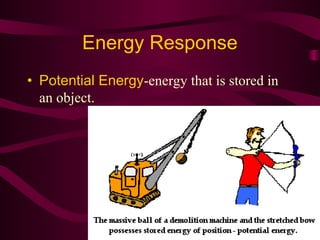Types of Energy Explained
•Download as PPT, PDF•
0 likes•772 views
There are six main types of energy: mechanical, thermal, chemical, electrical, electromagnetic, and nuclear. Mechanical energy deals with motion, thermal energy is generated by molecular motion, chemical energy is stored in bonds, and electrical energy powers devices. Electromagnetic energy travels in waves like radiation, while nuclear energy is stored in atoms and released during nuclear reactions. The law of conservation states that energy cannot be created or destroyed, only changed from one form to another.
Report
Share
Report
Share

Recommended
Recommended
More Related Content
What's hot
What's hot (20)
Similar to Types of Energy Explained
Similar to Types of Energy Explained (20)
More from Spencer56
More from Spencer56 (20)
Obj 3 forces that act on objects resulting in motion

Obj 3 forces that act on objects resulting in motion
Obj 1 relationship between energy, force, and motion

Obj 1 relationship between energy, force, and motion
Obj 3 rock and fossil evidence used to infer earth's history

Obj 3 rock and fossil evidence used to infer earth's history
Obj 1&2 compare ways plants and animals use energy and how they are dependant

Obj 1&2 compare ways plants and animals use energy and how they are dependant
Types of Energy Explained
- 1. Energy Response • Potential Energy-energy that is stored in an object.
- 2. Energy Response • Kinetic Energy-energy in motion
- 3. Energy • There are six types of energy. -mechanical, thermal, chemical, electrical, electromagnetic, and nuclear
- 4. Energy • Mechanical energy deals with motion. • Thermal energy is created when molecules within matter move so fast that heat is generated.
- 5. Energy • Chemical energy is stored in chemical compounds by chemical bonds • Electrical energy is used to power all electrical things
- 6. Energy • Electromagnetic energy travels in waves. Examples: radiation, microwaves, radio waves, satellite waves. • Nuclear energy is stored in atoms and when released during a nuclear reaction, it gives off a great amount of energy.
- 7. Energy • Law of Conservation-Energy cannot be created nor destroyed. Energy can change its form, but the amount of energy will remain the same before and after each transfer.